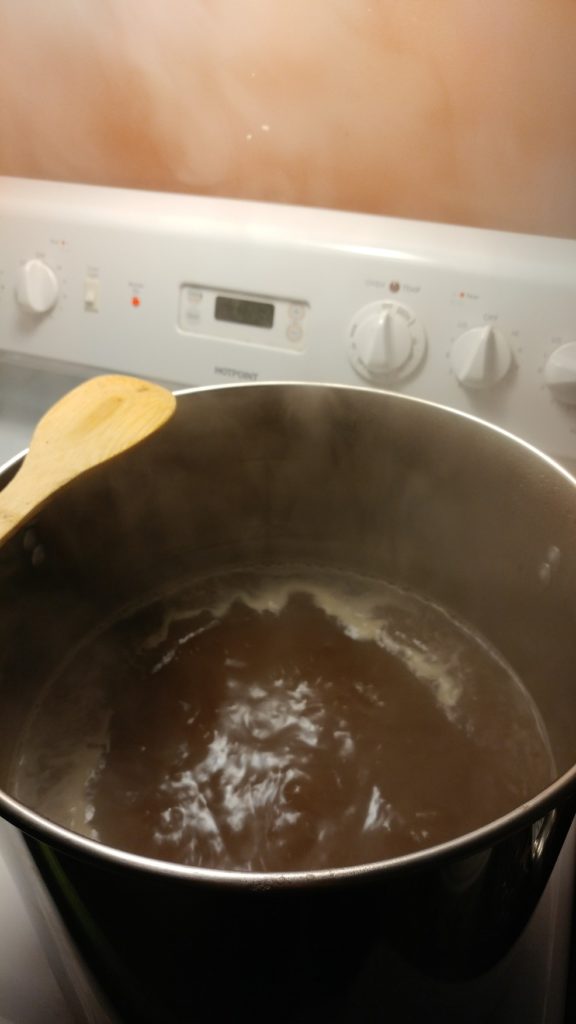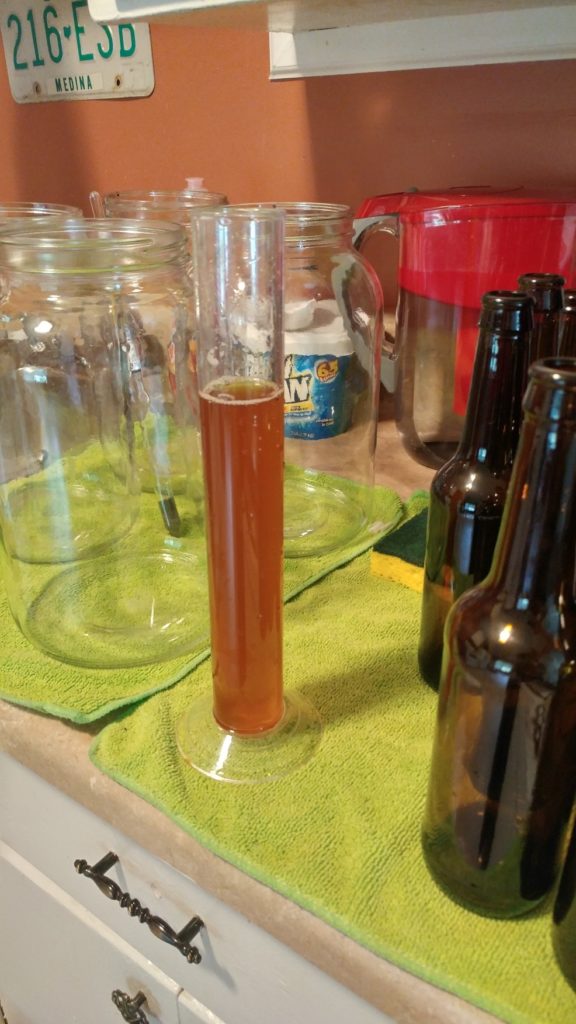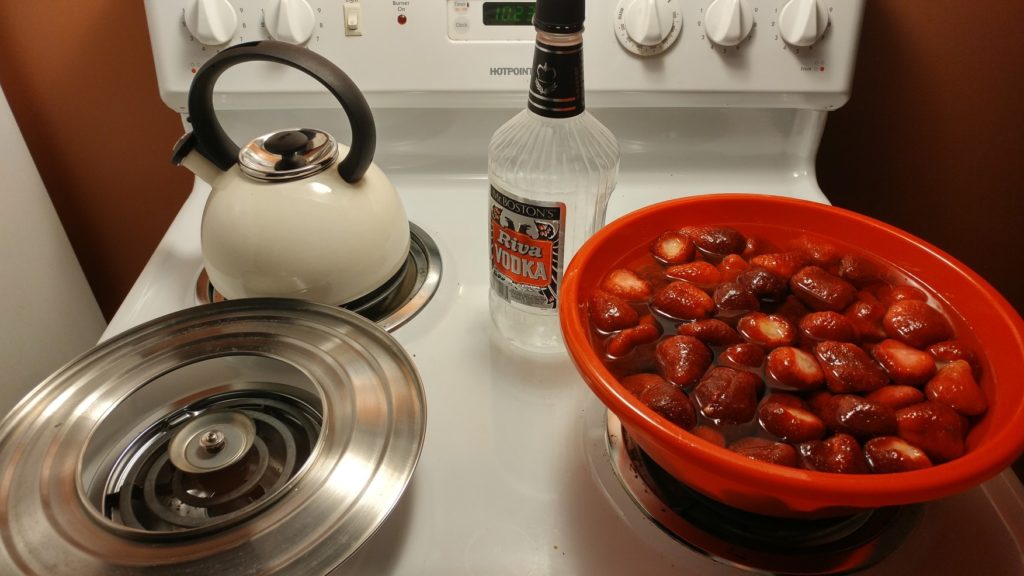What’s Next?
Wednesday, September 26, 2018
I ordered an Oatmeal Stout recipe from Adventures in Homebrewing with Safale S-04 yeast. I’ve always liked Highland Brewing’s Oatmeal Porter, so I thought I’d give it a go.
Also, as an inspiration, Dan just brewed a stout recipe. His plan was to add a homemade cold press coffee to it in secondary. That turned out pretty good, BTW.
Tasting – Strawbeery
Monday, September 24, 2018
Holy moly. This beer is explosive.
Apparently, I didn’t get my 80/20 priming sugar measurement correct, because this batch is so much more carbonated than the first gallon of Backyard Pilsner. It’s like champagne.
After a couple of days, I ended up moving the whole batch into the refrigerator to stop any further carbonation. I was worried about bottle bombs.
The smell is like a basket of fresh strawberries. The immediate taste, to me, is grapefruit. Very sour. Very citrus. The after taste is the old familiar iodine, band-aids flavor that I got with the first, unmolested batch.
Your beer is good. It’s very fizzy, but that’s fine. The strawberry is very present, but not too much. I had April try it and she said it’s “citrusy”. If I didn’t know it was strawberry, I might not have guessed too?
Dan’s Strawbeery review
There is a strawberry after taste that sneaks up on you.
He also later said “It tastes like old strawberries. I’ve tasted old strawberries.” haha
It has been a very wet summer and there are gnats everywhere. Even at work in the overly temperature controlled and twice weekly cleaned office. I sacrificed one of these beers (because it’s kind of yucky) with a drop of dish washing liquid as a gnat trap. By the end of the next day, there was a layer of dead gnats in the bottom of the glass.
More.
Wednesday, September 19, 2018
Adventures in Homebrewing had a free shipping sale going on, so Dan and I went in together and bought two more fermenting buckets.
It’s a long wait from fermenting to bottling to enjoying. The rare optimistic outlook that I will in the future be able to enjoy them. Thus far, not much success.
My plan is to do a batch of apple jack, which has to live in the fermenter for a month or more. Also, in the future, it would be nice to have a couple of batches going at a time at different stages.
Brew Day – Summer Ale
Tuesday, September 18, 2018
Dan had previously brewed this Brewer’s Best Summer Ale recipe with great and easy success. As with my previous batch, my intent was to do something interesting with the recipe.
Code name: Fale All (lowered expectations Fall Ale)
I set aside the bag of dried lemon and orange peel that came with the recipe kit. Instead, I bought three big naval oranges, cloves, and cinnamon. I zested all three oranges into a big wet, oily pile, mixed in ten cloves, and covered it all in ground cinnamon. I left this in the refrigerator overnight, wrapped in plastic.
I got the idea from a recipe I found online for homemade Constant Comment tea. A fall ale seemed more appropriate for this time of year.

I added the orange, clove, and cinnamon into the last ten minutes of the boil. Before transferring over to the fermenter, I strained out all of the cloves and orange zest.
Original Gravity: 1.042
Brew day went off without a hitch.
Bottling Day – Backyard Pilsner – Part Two
Sunday, September 16, 2018
Code name: Strawbeery
After a week in secondary with strawberries, it was time to bottle the remaining four gallons. The strawberries had turned yellowish-gray and the beer was pink.
Because of the problems with the butterfly capper the previous weekend, I designed and built “The Capperatus” from scrap 2×6 blocks that were laying around in the basement. I used a hole saw that was large enough to fit a soup can. A couple of layers of microfiber rags made for a snug fit inside and outside of the can. Also, it couldn’t hurt to have a little cushion.

After a couple of trial runs, the top wood block split, but otherwise the concept worked well.
I scooped out all of the strawberry sludge from the gallon jars and racked into the bottling bucket with the remaining 80% of the priming sugar.
Since the top block of The Capperatus split in testing, I capped the bottles using the bottom half to keep the bottles stable. It did a great job of that. I used the aforementioned “John Henry” rubber mallet technique without incident.
Tasting – Backyard Pilsner
Saturday, September 15, 2018
With a bit of nerves, I cracked open my first bottle of my first batch of beer.
It didn’t have much carbonation. What it did have, in abundance, was a medicinal smell. It smelled and tasted like I had fermented the IO Star sanitizer.
Not great.
Luckily, there is only one gallon of this mess. Let’s hope the strawberry batch turns out better.
Bottling Day – Backyard Pilsner – Part One
Sunday, September 9, 2018
I took the four glass fermenting jars and added varying amounts of strawberries that had soaked overnight in vodka. The idea was to later bottle the beer individually out of these jars and figure out which ratio of strawberries to beer tasted best.

For some reason, final gravity measured 1.040, which was exactly the same as the original gravity. This made me question my ability to read the hydrometer. Either that, or the accuracy of the hydrometer.
The beer tasted strange – heavy and medicinal. That is not what I was expecting from a pilsner.
I prepared roughly 20% of a 5oz pack of priming sugar (calculated in tablespoons) and racked the remaining gallon of beer into the bottling bucket.
Bottling went smoothly. However, the capping did not. The butterfly capper that came with my brew kit didn’t grab these bottle necks properly. It was clamping metal plates directly against the bottle necks.
Fearing I would break or at least crack a bottle neck, I abandoned the capper. I had previously read someone else’s tale of having the same problem. Their emergency bottling day solution was to whack the removable capper bell with a rubber mallet.
I did the same.
No bottles were broken, but what a shit show…
Mr. Boston’s Strawberry Bath
Friday, September 7, 2018
The plan is to try making this plain ol’ pilsner recipe a little more interesting. I’m going to split off some of the beer into secondary fermenter with added strawberries. I bought a five pound bag of frozen jumbo strawberries at the grocery store.
To keep from introducing bacteria or stray yeast into your brew, a common practice is to soak additives in vodka. As with everything else, online opinions vary on the frozen strawberries, whether or not they need to be sanitized.
I decided to play it safe and soaked them overnight in vodka in the refrigerator. I bought a handle of the cheapest vodka I could find – Mr. Boston’s Riva Vodka – for $11.
